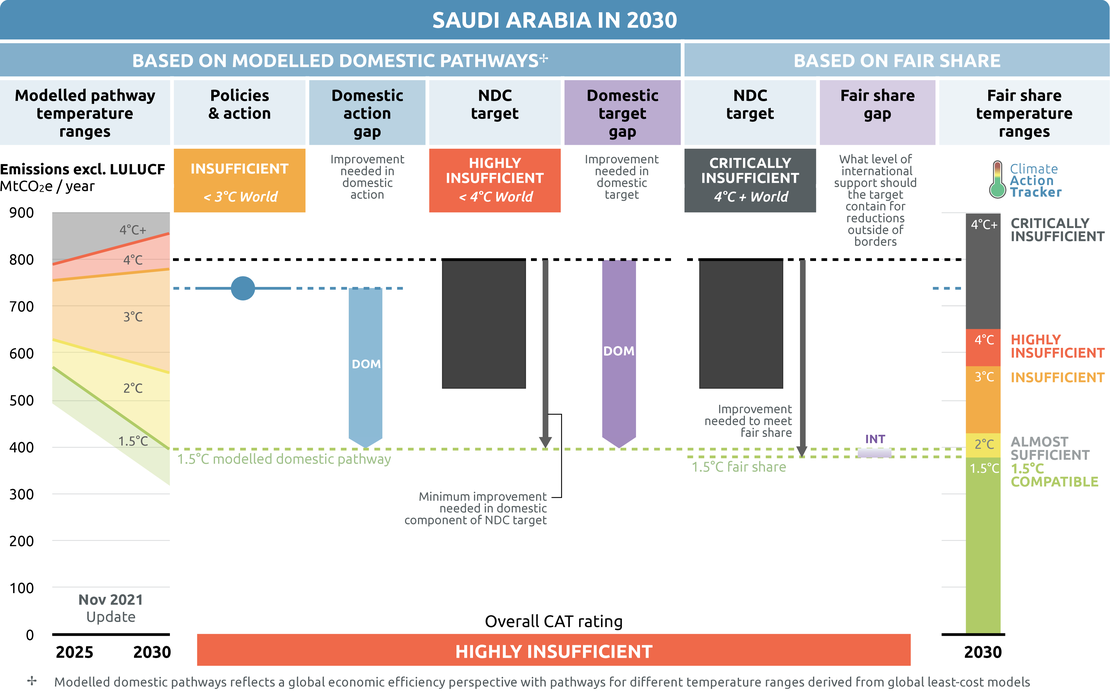Targets
Paris Agreement targets
NDC description
Saudi Arabia submitted its updated NDC on 23 October 2021, increasing the 2030 emissions reduction target from 130 MtCO2e in the first NDC to 278 MtCO2e in the updated one.
We interpret the NDC target to be a reduction below a baseline scenario, similarly to the previous one, although this is not explicitly mentioned in the document. It is however important to note that neither the previous NDC nor the updated one includes a baseline projection to which the emissions reduction target is applied.
The updated NDC, similarly to the previous version, mentions that the reduction target is contingent on international climate action under the Paris Agreement not causing an “abnormal burden” on its economy. The NDC specifically mentions that the emissions reductions are based on a scenario under which hydrocarbons exports continue to provide a ‘robust contribution’ to the Saudi economy.
Under a second scenario, which we understand to be a scenario under which global hydrocarbons exports decline, Saudi Arabia would continue what it calls a ‘sustainable utilisation of hydrocarbons’ domestically. Under this scenario, Saudi Arabia reserves itself the right to revise its NDC.
With many of the world’s major economies having put forward net zero targets—and increased electrification trends in sectors such as electricity and transport, global oil consumption is expected to significantly decrease in the coming decades (IEA, 2021a). While the impacts on Saudi Arabian oil exports remain unclear, as it has lower production costs than many other oil exporting countries (NBER, 2018), it would be important for the Saudi government to develop a scenario that is both compatible with the Paris Agreement and that takes these global developments into account.
The NDC lists the following mitigation measures:
- Energy efficiency, particularly in the industry, buildings, and transport sectors
- Renewable energy in the power sector, making up 50% of the electricity mix by 2030, and to generate green hydrogen
- A switch from oil to gas in the electricity sector
- Carbon capture utilisation and storage (CCUS), coupled with blue hydrogen
- A 30% reduction in methane emissions by 2030 (compared to 2020 levels)
As Saudi Arabia has not yet communicated the business as usual (BAU) range for its NDC target, we quantified the target based on a business as usual scenario developed by the King Abdullah Petroleum Studies and Research Center (KAPSARC). The lower end of the BAU range reflects the KAPSARC BAU scenario, excluding land use, land use change and forestry (LULUCF). For the upper end of the range, we have assumed that LULUCF measures would contribute 200 MtCO2e of the total 278 MtCO2e emissions reductions in the NDC. This number is based on the announcements made at the Saudi Green Initiative Forum. While there are questions around the feasibility of this target, we have included it to reflect uncertainties around the baseline used for the NDC. In 2012, the latest year for which national data is available, the land use and forestry sink stood at just 9 MtCO2e (UNFCCC, 2020), with forests covering a mere 0.5% of Saudi Arabia’s total land area in 2020 (World Bank, 2021).
Based on this BAU range, and due to the uncertainties around the contributions of emissions reductions from land use and forestry, we project Saudi Arabia’s NDC emissions level to be anywhere between 520–800 MtCO2e in 2030, excluding LULUCF. This represents an approximate change of -19% to +24% compared 2019 levels, or 146–275% above 1990 levels.
The CAT rates Saudi Arabia's target as "Critically insufficient" when rated against the fair share contribution ("NDC target against fair share") and as “Highly insufficient” when rated against modelled domestic pathways ("NDC target against modelled domestic pathways"). Saudi Arabia does not specify a conditional target or an international element in its NDC, so we rate the same target against the two rating frameworks.
We rate the proposed 2030 reduction target levels as “Highly insufficient” when compared to domestic pathways (derived from global least cost modelled domestic pathways). The “Highly insufficient” rating indicates that Saudi Arabia’s NDC target against modelled domestic pathways in 2030 leads to rising, rather than falling, emissions and is not at all consistent with the 1.5°C temperature limit. If all countries were to follow Saudi Arabia’s approach, warming could reach over 3°C and up to 4°C.
We rate Saudi Arabia’s NDC target against fair share “Critically insufficient”. The “Critically insufficient” rating indicates that Saudi Arabia’s NDC target in 2030 reflects minimal to no action and is not at all consistent with the 1.5°C temperature limit when compared to its fair share. Saudi Arabia’s target is not in line with any interpretation of a fair approach to meeting the 1.5°C temperature limit. If all countries were to follow Saudi Arabia’s approach, warming would exceed 4°C.
Further information on how the CAT rates countries (against modelled domestic pathways and fair share) can be found here.
Net zero and other long-term target(s)
We evaluate the target as: Target information incomplete.
For our full Saudi Arabia's net zero analysis click here.
Further analysis
Latest publications
Stay informed
Subscribe to our newsletter





